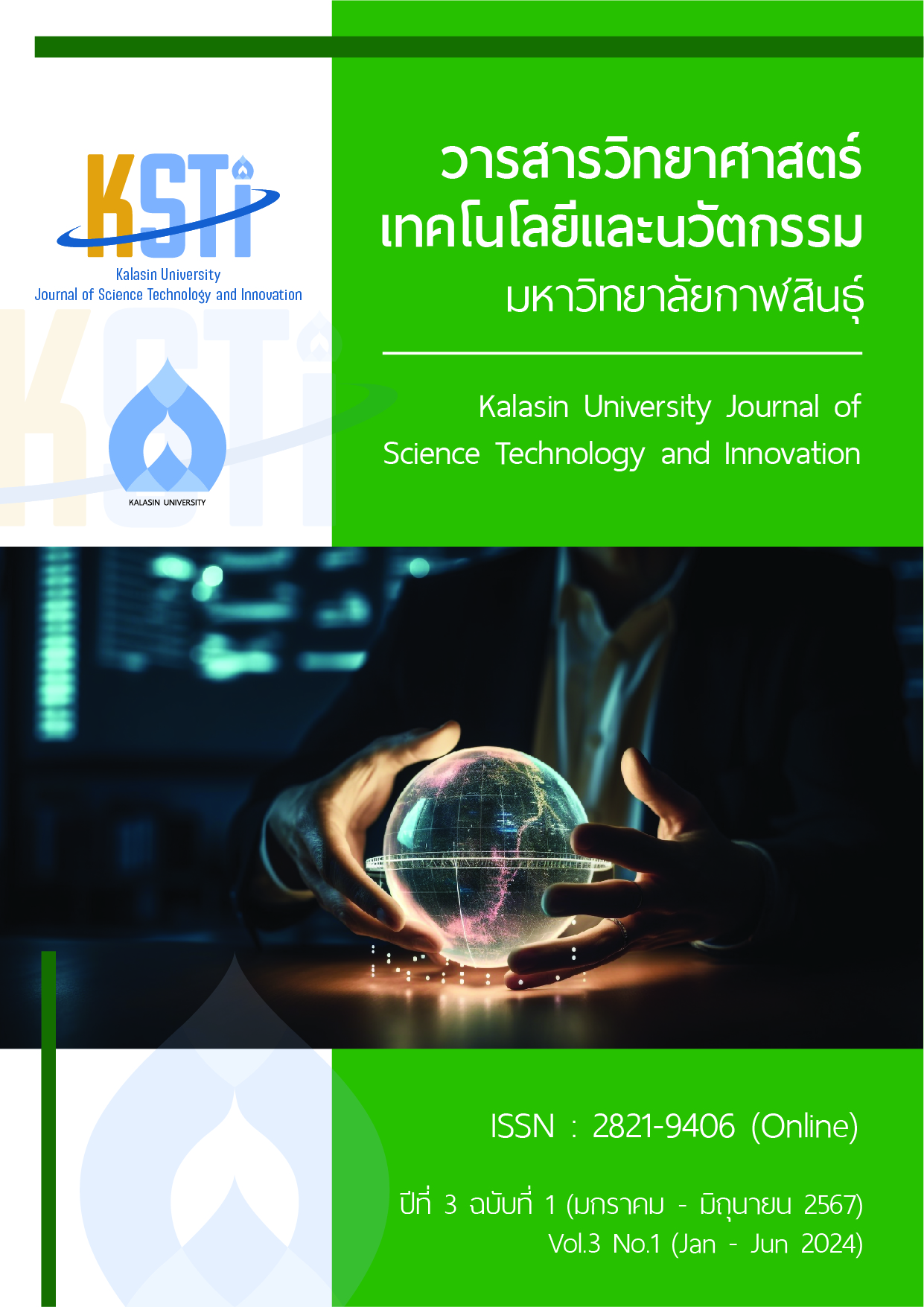ความชุกและปัจจัยที่มีความสัมพันธ์กับความเครียด ภาวะหมดไฟในการทำงานและประสิทธิภาพในการทำงานของผู้ปฏิบัติงานในอุตสาหกรรมเฟอร์นิเจอร์ภายใต้สถานการณ์ การแพร่ระบาดของโรคโควิด 19
Main Article Content
บทคัดย่อ
งานวิจัยนี้มีวัตถุประสงค์เพื่อศึกษาความชุกและปัจจัยที่มีความสัมพันธ์กับความเครียด ภาวะหมดไฟในการทำงานและประสิทธิภาพในการทำงานของผู้ปฏิบัติงานในอุตสาหกรรมเฟอร์นิเจอร์ที่เป็นสถานประกอบการขนาดเล็กภายใต้สถานการณ์การระบาดของโควิด 19 กลุ่มตัวอย่างเป็นพนักงานระดับปฏิบัติการ จำนวน 120 คน จากสถานประกอบการจำนวน 10 แห่ง หาขนาดของกลุ่มตัวอย่างโดยใช้สูตรประมาณค่าสัดส่วนทราบประชากร และสุ่มตัวอย่างด้วยวิธีแบบเลือกโดยการสุ่มอย่างง่าย ทำการวิเคราะห์ข้อมูลทั่วไปด้วยสถิติเชิงพรรณนา และวิเคราะห์หาความสัมพันธ์ของตัวแปรโดยใช้สถิติไคสแควร์ ผลการวิจัยพบว่า ความเครียดในทำงานของผู้ปฏิบัติงานมีค่าเฉลี่ย 0.99 อยู่ในระดับน้อย ภาวะหมดไฟในการทำงานมีค่าเฉลี่ย 2.09 อยู่ในระดับปานกลาง และประสิทธิภาพในการปฏิบัติงานมีค่าเฉลี่ย 3.18 อยู่ในระดับปานกลาง ความเครียดในการทำงานในด้านปริมาณงานและความกดดันด้านเวลา และด้านพฤติกรรม มีความสัมพันธ์กับภาวะหมดไฟในการทำงาน โดยมีค่าทางสถิติ ที่ .000 และ .011 ตามลำดับ ความเครียดในการปฏิบัติงานมีความสัมพันธ์กับประสิทธิภาพในการทำงานของผู้ปฏิบัติงาน โดยมีค่าทางสถิติที่ .002 ภาวะหมดไฟในการทำงาน ในด้านความอ่อนล้าทางอารมณ์ มีความสัมพันธ์กับประสิทธิภาพในการทำงานของผู้ปฏิบัติงาน ในด้านการปรับตัวและการปฏิบัติตน โดยมีค่าทางสถิติที่ .020 ที่ระดับนัยสำคัญ .05
Downloads
Article Details

อนุญาตภายใต้เงื่อนไข Creative Commons Attribution-NonCommercial-NoDerivatives 4.0 International License.
เจ้าของลิขสิทธิ์ (สถาบันวิจัยและพัฒนา มหาวิทยาลัยกาฬสินธุ์) ผู้เขียน ตกลงว่าการทำสำเนาบทความหรือส่วนใดส่วนหนึ่งของบทความดังกล่าวในรูปแบบสิ่งพิมพ์หรืออิเล็กทรอนิกส์ตามที่ได้รับอนุญาต จะต้องระบุประกาศลิขสิทธิ์ตามที่กำหนดไว้ในวารสาร พร้อมทั้งอ้างอิงข้อมูลฉบับสมบูรณ์ของบทความที่ตีพิมพ์ในวารสารที่จัดทำโดย สถาบันวิจัยและพัฒนา มหาวิทยาลัยกาฬสินธุ์ อย่างครบถ้วนทุกครั้ง
เอกสารอ้างอิง
Arnsten AFT, Shanafelt T. Physician Distress and Burnout: The Neurobiological Perspective. Mayo Clin Proc [Internet] 2021; 96(3): 763–9.
Adesse D, Gladulich L, Alvarez-Rosa L, Siqueira M, Marcos AC, Heider M, et al. Role of aging in Blood–Brain Barrier dysfunction and susceptibility to SARS-CoV-2 infection: impacts on neurological symptoms of COVID-19. Fluids Barriers CNS [Internet] 2022; 19(1): 1–19.
Donthu N, Gustafsson A. Effects of COVID-19 on business and research. J Bus Res 2020; 117: 284–9.
Kaur K. The Early Impact of COVID-19 on Textile Industry: An Empirical Analysis. Manag Labour Stud 2021; 46(3): 235–47.
Cañadas-De la Fuente GA, Vargas C, San Luis C, García I, Cañadas GR, De la Fuente EI. Risk factors and prevalence of burnout syndrome in the nursing profession. Int J Nurs Stud 2015; 52(1): 240–9.
Maslach C, Schaufeli WB, Leiter MP. Job Burnout Annual Review of Psychology. J Organ Behav 2001; 52: 397–422.
Tucker SJ, Weymiller AJ, Cutshall SM, Rhudy LM, Lohse CM. Stress ratings and health promotion practices among RNs: A case for action. J Nurs Adm 2012; 42(5): 282–92.
Verougstraete D, Hachimi Idrissi S. The impact of burn-out on emergency physicians and emergency medicine residents: a systematic review. Acta Clin Belgica Int J Clin Lab Med 2020; 75(1): 57–79.
Masahiro S, Yuko O, Yumiko O, Teruichi S, Tage SK, Toshimasa M. Relationship of Nurse Burnout with Personality Characteristics and Coping Behaviors. Ind Health 2008; 46: 326–35.
Adriaenssens J, de Gucht V, Maes S. The impact of traumatic events on emergency room nurses: Findings from a questionnaire survey. Int J Nurs Stud [Internet] 2012; 49(11): 1411–22.
Brinkert R. A literature review of conflict communication causes, costs, benefits and interventions in nursing. J Nurs Manag 2010; 18(2): 145–56.
Ironside K, Becker D, Chen I, Daniyan A, Kian A, Saheba N, et al. Resident and Faculty Perspectives on Prevention of Resident Burnout: A Focus Group Study. Perm J 2019; 23: 18–185.
Aydemir O, Icelli I. Burnout: Risk factors. In: Burnout for Experts: Prevention in the Context of Living and Working 2013. p. 119–43.
Duan N, Hoagwood K. Purposeful Sampling for Qualitative Data Collection and Analysis in Mixed Method Implementation Research. Adm Policy Ment Heal Ment Heal Serv Res [Internet] 2015; 42: 533–44.
พรชัย สิทธิศรัณย์กุล. ภาวะหมดไฟในการทำงาน. [Internet]. กรมสุขภาพจิต. 2563 [เข้าถึงเมื่อ 10 มีนาคม 2565]. เข้าถึงจาก: https://dmh.go.th/news/view.asp?id=2270
เบญจมาศ อิ่มมาก. คุณภาพชีวิตและความเครียดในการปฏิบัติงานที่มีอิทธิพลต่อประสิทธิภาพการปฏิบัติงานในอุตสาหกรรมเครื่องปรับอากาศและเครื่องทำความเย็น (วิทยานิพนธ์ปริญญาบริหารธุรกิจมหาบัณฑิต). ปทุมธานี:มหาวิทยาลัยราชมงคลธัญบุรี; 2558.
Ansoleaga E. Indicadores de salud mental asociados a riesgo psicosocial laboral en un hospital público. Rev. Med. Chile 2015; 143: 47–55.
Lu D.M, Sun N, Hong S, Fan Y.Y, Kong F.Y, Li Q.J. Occupational Stress and Coping Strategies among Emergency Department Nurses of China. Arch Psychiatr Nurs 2015; 29: 208–212.
Suthum S, Chaiyakul T. Influences of work factor on work stress affecting job performance of operational employees in automotive parts manufacturing industry in laem chabang industrial estate. Phuket Rajabhat Univ Acad J 2020; 16(2): 77–95.
Bishop S.R, Lau M, Shapiro S, Carlson L, Anderson N.D, Carmody J, Segal Z.V, Abbey S, Speca M, Velting D. Mindfulness: A Proposed Operational Definition. Clin. Psychol. Sci. Pract 2006; 11:230–241.
Kuper H, Marmot M. Job strain, job demands, decision latitude, and risk of coronary heart disease within the Whitehall II study. J. Epidemiol. Community Health 2003; 57: 147–153.
Tsutsumi A, Kayaba K, Theorell T, Siegrist J. Association between job stress and depression among Japanese employees threatened by job loss in a comparison between two complementary job-stress models. Scand. J. Work Environ. Health 2001; 27: 146–153.
Kaewsrasean P, Archarunjroj P. The Relationships Between Work Related Factors, Stress and Performance Efficiency Among Real Estate Company Employees in Bangkok. Veridian E-Journal, Silpakorn University Humanities, Social Sciences and Arts 2017; 10(1): 1042-1057.
Unlamai N, Thermtiptaweekul K, Chienwattanasook K. Stress Management in The Workplace to Maximize Employee Efficiency. Journal of Management Science Nakhon Pathom Rajabhat University 2018; 5(1): 104-117.
เต็มสิริ ป.ปาน. Work Burnout among Dental Nurses in Songkhla Province. ว ทันต สธ 2564; 26:24–36.
Kristensen TS, Borritz M, Villadsen E, Christensen KB. The Copenhagen Burnout Inventory: A new tool for the assessment of burnout. Work Stress 2005; 19(3): 192-207.
Freudenberger HJ. The staff burn-out syndrome in alternative institutions. Psychotherapy: Theory, Research & Practice 1975; 12(1): 73-82.
Valadez T, Sonia G. Analysis of Burnout Syndrome, Musculoskeletal Complaints, and Job Content in Middle and Senior Managers: Case Study of Manufacturing Industries in Ciudad Júarez, Mexico. Work 2017; 58(4): 549–65.
อดิลักษณ์ พุ่มอิ่ม. การพัฒนารูปแบบความสัมพันธ์เชิงสาเหตุของปัจจัยด้านงาน ความเครียดในการทํางาน ที่มีอิทธิพลต่อประสิทธิภาพในการปฏิบัติงาน ของพนักงานในนิคมอุตสาหกรรมเกตเวย์ซิต. วารสารวิทยาลัย โลจิสติกส์และซัพพลายเชน 2564; 7(2): 122–35
ทีปพิพัฒน์ เลิศวรายุทธ์, สรา อาภรณ์, ไชยนันต์ แท่งทอง, จุฑาธิป ศีลบุตร. ระดับความเครียดที่เกิดจากการทำงานของพนักงานฝ่ายผลิตในโรงงานอิเล็กทรอนิกส์. วารสารความปลอดภัยและสิ่งแวดล้อม 2561; 3(2): 18–26.
ปาลินี สุขคุ้ม, ศรสวรรค์ สุภาพปัญญา, ยุทธพงศ์ ทัดวอน. การศึกษาแนวทางในการเผชิญความเครียดในยุคชีวิตวิถีใหม่ของพนักงานกลุ่มอุตสาหกรรมปิโตรเคมีจังหวัดระยอง. วารสารบริหารธุรกิจอุตสาหกรรม 2564; 3(2): 30–45.
Kaewkiew P. A Study of Stress Levels and Work Efficiency of Teachers of Special Education in the Bangkok metropolitan Area. Journal of Multidisciplinary in Social Sciences 2014; 10(1): 59-76.
Macias V, Sharon C. Burnout Syndrome in Middle and Senior Management in the Industrial Manufacturing Sector of Mexico. International journal of environmental research and public health 2019; 16(8): 1–17.
Maslach C. Job Burnout NewDirections in Research and Intervention. Curr. Dir. Psychol. Sci 2003; 12: 189–192.
Bakker A.B, Demerouti E, Taris A.W.T, Schaufeli W.B, Schreurs P.J.G. A Multigroup Analysis of the Job Demands-Resources Model in Four Home Care Organizations. Int. J. Stress Manag 2003; 10: 16–38.
Javanshir E, Iman D, Mohammad A.J. Psychometric Properties of the Iranian Version of the Copenhagen Burnout Inventory. Health Promotion Perspectives 2019; 9(2): 137–42.


